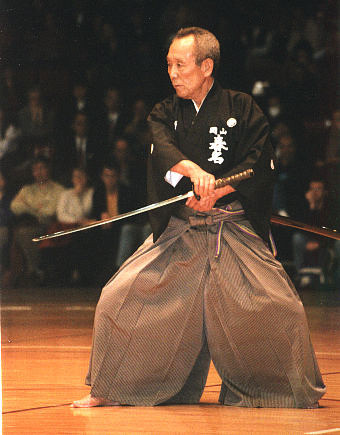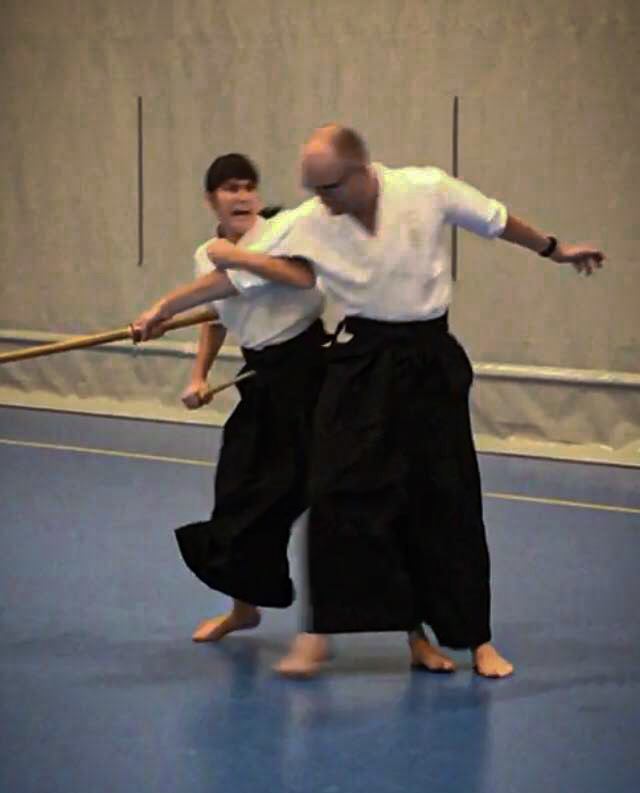|
Bansen Tanaka
was a Japanese aikido master and a pre-war and post-war disciple of aikido founder Morihei Ueshiba. Tanaka was a judo practitioner when he met Ueshiba in 1936. Eager to learn about aikido, he set up a dojo in Osaka for Noriaki (Yoichiro) Inoue, early student and nephew of Ueshiba. He followed Inoue and Ueshiba's teachings until 1939 when he was drafted to go to war. His proficiency in aikido secured him a position as a bodyguard in the army. He returned to Osaka after the war and resumed the practice of aikido. He also went to Iwama (during the construction of his dojo in Osaka) and trained alongside other renowned students of Ueshiba. He was one of the few students who trained with Ueshiba before and after the war. Ueshiba contacted Tanaka in 1951 and suggested him to build his own dojo in Osaka, the future Osaka Aikikai Dojo. After the dojo's inauguration (early 1952), Ueshiba spent several months there teaching aikido and he frequently returned to visit and teach. Tanak ... [...More Info...] [...Related Items...] OR: [Wikipedia] [Google] [Baidu] |
Osaka
is a designated city in the Kansai region of Honshu in Japan. It is the capital of and most populous city in Osaka Prefecture, and the third most populous city in Japan, following Special wards of Tokyo and Yokohama. With a population of 2.7 million in the 2020 census, it is also the largest component of the Keihanshin Metropolitan Area, which is the second-largest metropolitan area in Japan and the 10th largest urban area in the world with more than 19 million inhabitants. Osaka was traditionally considered Japan's economic hub. By the Kofun period (300–538) it had developed into an important regional port, and in the 7th and 8th centuries, it served briefly as the imperial capital. Osaka continued to flourish during the Edo period (1603–1867) and became known as a center of Japanese culture. Following the Meiji Restoration, Osaka greatly expanded in size and underwent rapid industrialization. In 1889, Osaka was officially established as a municipality. The construc ... [...More Info...] [...Related Items...] OR: [Wikipedia] [Google] [Baidu] |
Atemi
In Japanese martial arts, the term designates blows or strikes to the body, as opposed to twisting of joints, strangleholds, holding techniques and throws. Atemi can be delivered by any part of the body to any part of the opponent's body. They can be percussive or use "soft" power. Karate is a typical martial art focusing on percussive atemi. The location of nerve and pressure points, such as might be used for certain acupressure methods, also often informs the choice of targets for atemi (see kyusho). Some strikes against vital parts of the body can kill or incapacitate the opponent: on the solar plexus, at the temple, under the nose, in the eyes, genitals, or under the chin. Traditional Japanese martial arts (the ancestors of judo, jujutsu, and aikido) do not commonly practice atemi, since they were supposed to be used on the battlefield against armoured opponents. However, there are certain exceptions. Atemi can be complete techniques in and of themselves, but are al ... [...More Info...] [...Related Items...] OR: [Wikipedia] [Google] [Baidu] |
Japanese Aikidoka
Japanese may refer to: * Something from or related to Japan, an island country in East Asia * Japanese language, spoken mainly in Japan * Japanese people, the ethnic group that identifies with Japan through ancestry or culture ** Japanese diaspora, Japanese emigrants and their descendants around the world * Japanese citizens, nationals of Japan under Japanese nationality law ** Foreign-born Japanese, naturalized citizens of Japan * Japanese writing system, consisting of kanji and kana * Japanese cuisine, the food and food culture of Japan See also * List of Japanese people * * Japonica (other) * Japonicum * Japonicus * Japanese studies Japanese studies (Japanese: ) or Japan studies (sometimes Japanology in Europe), is a sub-field of area studies or East Asian studies involved in social sciences and humanities research on Japan. It incorporates fields such as the study of Japanese ... {{disambiguation Language and nationality disambiguation pages ... [...More Info...] [...Related Items...] OR: [Wikipedia] [Google] [Baidu] |
1988 Deaths
File:1988 Events Collage.png, From left, clockwise: The oil platform Piper Alpha explodes and collapses in the North Sea, killing 165 workers; The USS Vincennes (CG-49) mistakenly shoots down Iran Air Flight 655; Australia celebrates its Bicentennial on January 26; The 1988 Summer Olympics are held in Seoul, South Korea; Soviet troops begin their withdrawal from Afghanistan, which is completed the next year; The 1988 Armenian earthquake kills between 25,000-50,000 people; The 8888 Uprising in Myanmar, led by students, protests the Burma Socialist Programme Party; A bomb explodes on Pan Am Flight 103, causing the plane to crash down on the town of Lockerbie, Scotland- the event kills 270 people., 300x300px, thumb rect 0 0 200 200 Piper Alpha rect 200 0 400 200 Iran Air Flight 655 rect 400 0 600 200 Australian Bicentenary rect 0 200 300 400 Pan Am Flight 103 rect 300 200 600 400 1988 Summer Olympics rect 0 400 200 600 8888 Uprising rect 200 400 400 600 1988 Armenian ... [...More Info...] [...Related Items...] OR: [Wikipedia] [Google] [Baidu] |
1912 Births
Year 191 ( CXCI) was a common year starting on Friday (link will display the full calendar) of the Julian calendar. At the time, it was known as the Year of the Consulship of Apronianus and Bradua (or, less frequently, year 944 ''Ab urbe condita''). The denomination 191 for this year has been used since the early medieval period, when the Anno Domini calendar era became the prevalent method in Europe for naming years. Events By place Parthia * King Vologases IV of Parthia dies after a 44-year reign, and is succeeded by his son Vologases V. China * A coalition of Chinese warlords from the east of Hangu Pass launches a punitive campaign against the warlord Dong Zhuo, who seized control of the central government in 189, and held the figurehead Emperor Xian hostage. After suffering some defeats against the coalition forces, Dong Zhuo forcefully relocates the imperial capital from Luoyang to Chang'an. Before leaving, Dong Zhuo orders his troops to loot the tombs of the H ... [...More Info...] [...Related Items...] OR: [Wikipedia] [Google] [Baidu] |
Japanese Cuisine
Japanese cuisine encompasses the regional and traditional foods of Japan, which have developed through centuries of political, economic, and social changes. The traditional cuisine of Japan (Japanese: ) is based on rice with miso soup and other dishes; there is an emphasis on seasonal ingredients. Side dishes often consist of fish, pickled vegetables, and vegetables cooked in broth. Seafood is common, often grilled, but also served raw as sashimi or in sushi. Seafood and vegetables are also deep-fried in a light batter, as '. Apart from rice, a staple includes noodles, such as soba and udon. Japan also has many simmered dishes, such as fish products in broth called , or beef in and . Historically influenced by Chinese cuisine, Japanese cuisine has also opened up to influence from Western cuisines in the modern era. Dishes inspired by foreign food—in particular Chinese food—like ramen and , as well as foods like spaghetti, curry and hamburgers, have been adapted to Japanes ... [...More Info...] [...Related Items...] OR: [Wikipedia] [Google] [Baidu] |
Japanese Calligraphy
also called is a form of calligraphy, or artistic writing, of the Japanese language. Written Japanese was originally based on Chinese characters only, but the advent of the hiragana and katakana Japanese syllabaries resulted in intrinsically Japanese calligraphy styles. Styles The term shodō (書道, "way of writing") is of Chinese origin, and is widely used to describe the art of Chinese calligraphy during the medieval Tang dynasty. Early Japanese calligraphy was originated from Chinese calligraphy. Many of its principles and techniques are very similar, and it recognizes the same basic writing styles: * seal script (篆書 ''tensho'') (pinyin: ''zhuànshū''). The seal script (tensho) was commonly used throughout the Zhou dynasty (1046–256 BC) and the following Qin dynasty (221–206 BC) of China. After this time period, tensho style fell out of popularity in favor of reisho. However, tensho was still used for titles of published works or inscriptions. The c ... [...More Info...] [...Related Items...] OR: [Wikipedia] [Google] [Baidu] |
Misogi
is a Japanese Shinto practice of ritual purification by washing the entire body. Misogi is related to another Shinto purification ritual called ''Harae'' – thus both being collectively referred to as . Background Every year, many people take pilgrimages to sacred waterfalls, lakes and rivers, either alone or in small groups, to perform misogi. Mount Ontake, the Kii mountain range and Mount Yoshino are but a few examples of ancient and well known areas for misogi in Japan. In Kyoto, people douse themselves under Kiyomizu Temple's ''Otowa no taki'' (Sound-of-Wings) waterfall, although the majority of visitors drink from the waters rather than plunging into them. In the United States misogi is performed at the Tsubaki Grand Shrine of America at the Konryu Myojin no Taki waterfall each morning. Before encountering misogi, members generally undergo some sort of preliminary purification. Such things as prayers, fasting, or some sort of physical activity is common. Generally, w ... [...More Info...] [...Related Items...] OR: [Wikipedia] [Google] [Baidu] |
Zazen
''Zazen'' (literally " seated meditation"; ja, 座禅; , pronounced ) is a meditative discipline that is typically the primary practice of the Zen Buddhist tradition. However, the term is a general one not unique to Zen, and thus technically any Buddhist tradition's seated meditation is "zazen". The term ''zuòchán'' can be found in early Chinese Buddhist sources, such as the Dhyāna sutras. For example, the famous translator Kumārajīva (344-413) translated a work termed ''Zuòchán sān mēi jīng'' (''A'' ''Manual on the Samādhi of Sitting Meditation'') and the Chinese Tiantai master Zhiyi (538–597 CE) wrote some very influential works on sitting meditation.Swanson, Paul L. (2002). ''Ch'an and Chih-kuan: T'ien-t’ai Chih-i's View of "Zen" and the Practice of the Lotus Sutra''. Presented at the International Lotus Sutra Conference on the theme "The Lotus Sutra and Zen", 11–16 July 2002. Source: (accessed: 6 August 2008). p.4 The earliest manual on sitting meditati ... [...More Info...] [...Related Items...] OR: [Wikipedia] [Google] [Baidu] |
Bokken
A ''bokken'' (, , "wood", and ''ken'', "sword") (or a ''bokutō'' ) is a Japanese wooden sword used for training in kenjutsu. It is usually the size and shape of a ''katana'', but is sometimes shaped like other swords, such as the ''wakizashi'' and ''tantō''. Some ornamental ''bokken'' are decorated with mother-of-pearl work and elaborate carvings. Sometimes it is spelled "boken" in English. ''Bokken'' are traditionally composed of red oak or white oak, although any hardwood can be used. In comparison, practice swords made of flexible, soft wood such as bamboo are referred to as ''shinai''. History It is hard to determine precisely when the first ''bokken'' appeared due to secrecy in ancient martial arts training and loose record-keeping. While various mock weapons were surely used during the earlier periods of Japanese history, usage of ''bokken'' in their modern form first emerged during the Muromachi Period (1336–1600) for the training of samurai warriors in the var ... [...More Info...] [...Related Items...] OR: [Wikipedia] [Google] [Baidu] |
Iaido
, abbreviated , is a Japanese martial art that emphasizes being aware and capable of quickly drawing the sword and responding to sudden attacks.Christensen, Karen and Allen Guttmann et.al (2001) ''International Encyclopedia of Women and Sports: H-R''. Macmillan Reference USA, Page 553. Iaido consists of four main components: the smooth, controlled movements of drawing the sword from its scabbard (or saya), striking or cutting an opponent, shaking blood from the blade, and replacing the sword in the scabbard.John Nauright, Charles Parrish, edited (2012) ''Sports Around the World: History, Culture, and Practice''. ABC-CLIO. Page 226. While beginning practitioners of iaido may start learning with a wooden sword (''bokken'') depending on the teaching style of a particular instructor, most of the practitioners use a blunt-edged sword called an iaitō or ''mogitō''.Armstrong, Hunter B. (1995) ''The koryu Bujutsu Experience'' in Koryu Bujutsu: Classical Warrior Traditions of Japan ... [...More Info...] [...Related Items...] OR: [Wikipedia] [Google] [Baidu] |
Tantojutsu
Tantōjutsu (短刀術) is a Japanese term for a variety of traditional Japanese knife fighting systems that used the tantō (短刀), a knife or dagger. Historically, many women used a version of the tantō, called the kaiken, for self-defense, but warrior women in pre-modern Japan learned one of the tantōjutsu arts to fight in battle. Martial arts that practise tantōjutsu Tantō with blunt wooden or plastic blades are used to practice martial arts. Metal blades can be used in more advanced training and in demonstrations. Styles that use tantō: Budō (Gendai): * Aikido * Shorinji Kempo Bugei: * Yanagi-ryu Aiki Bugei Bujutsu (Koryū): * Kashima Shin-ryū (this '' ryūha'' uses term Kaikenjutsu) * Takamura-ha Shindo Yoshin-ryu See also * Kaiken (dagger) * Wakizashi The is one of the traditionally made Japanese swords (''nihontō'') worn by the samurai in feudal Japan. History and use The production of swords in Japan is divided into specific time periods: [...More Info...] [...Related Items...] OR: [Wikipedia] [Google] [Baidu] |








